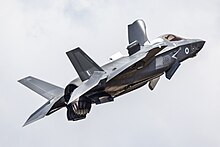
Back إقلاع وهبوط عمودي Arabic Şaquli enmə-qalxma Azerbaijani Самалёт вертыкальнага ўзлёту і пасадкі Byelorussian VTOL Catalan Ирхкема CE VTOL Czech VTOL Danish Senkrechtstart und -landung German VSKL-aviadilo Esperanto VTOL Spanish
A vertical take-off and landing (VTOL) aircraft is one that can take off and land vertically without relying on a runway. This classification can include a variety of types of aircraft including helicopters as well as thrust-vectoring fixed-wing aircraft and other hybrid aircraft with powered rotors such as cyclogyros/cyclocopters and gyrodynes.[1]

Some VTOL aircraft can operate in other modes as well, such as CTOL (conventional take-off & landing), STOL (short take-off & landing), or STOVL (short take-off & vertical landing). Others, such as some helicopters, can only operate as VTOL, due to the aircraft lacking landing gear that can handle taxiing. VTOL is a subset of V/STOL (vertical or short take-off & landing).
Some lighter-than-air aircraft also qualify as VTOL aircraft, as they can hover, takeoff and land with vertical approach/departure profiles.[2]
Electric vertical takeoff and landing aircraft, or eVTOLs, are being developed along with more autonomous flight control technologies and mobility-as-a-service (MaaS) to enable advanced air mobility (AAM), that could include on-demand air taxi services, regional air mobility, freight delivery, and personal air vehicles (PAVs).[3]
Besides the ubiquitous helicopters, there are currently two types of VTOL aircraft in military service: tiltrotor aircraft, such as the Bell Boeing V-22 Osprey, and thrust-vectoring airplanes, such as the Harrier family and new F-35B Lightning II Joint Strike Fighter (JSF). In the civilian sector currently only helicopters are in general use (some other types of commercial VTOL aircraft have been proposed and are under development as of 2017[update]). Generally speaking, VTOL aircraft capable of STOVL use it wherever possible, since it typically significantly increases takeoff weight, range or payload compared to pure VTOL.[4]
- ^ Laskowitz, I. B. (1961). "Vertical Take-Off and Landing (Vtol) Rotorless Aircraft with Inherent Stability". Annals of the New York Academy of Sciences. 93 (1): 3–24. Bibcode:1961NYASA..93....3L. doi:10.1111/j.1749-6632.1961.tb30485.x. ISSN 0077-8923. S2CID 84160729.
- ^ BILL VIRGIN (December 2017). "Plimp, a Plane-Blimp Hybrid, Is Looking to Disrupt the Drone Market - Seattle brothers James and Joel Egan are adding a new airship to the drone market, and it could be available as soon as next year". Seattle Business Magazine. Retrieved 16 November 2021.
- ^ Le Bris, G. et al. (2022). "ACRP Research Report 236: Preparing Your Airport for Electric Aircraft and Hydrogen Technologies". Transportation Research Board, Washington, DC: https://nap.nationalacademies.org/catalog/26512/preparing-your-airport-for-electric-aircraft-and-hydrogen-technologies
- ^ Khurana KC (2009). Aviation Management: Global Perspectives. Global India Publications. p. 133. ISBN 9789380228396.
© MMXXIII Rich X Search. We shall prevail. All rights reserved. Rich X Search